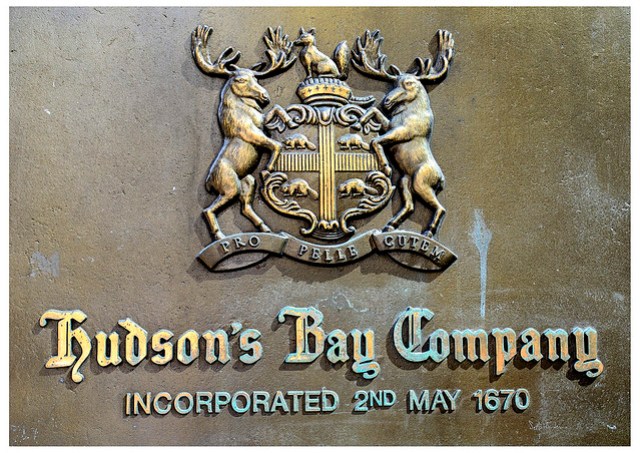I expect other retailers, museums and the like to follow with their own iBeacon programs this fall.
Hudson’s Bay Co., a pioneering North American business that was founded in 1670, is blazing trails in mobile marketing. Two of the Toronto-based company’s retail chains, Lord & Taylor and Hudson’s Bay, are getting on board the smartphone-triggered beacons trend with a test program rolling out today in 10 stores.
While Hudson’s Bay Co. certainly is not the first department store to experiment with beacons (Macy’s ran a test in New York and San Francisco last year), it claims to be the first to do so in multiple locations across the United States and Canada. The Lord & Taylor stores participating in the U.S. include New York’s flagship Fifth Avenue store, a location in Westchester, N.Y., and three shops in Massachusetts. North of the border, Hudson’s Bay stores in Toronto, Calgary, Vancouver and Ottawa are testing the technology.
“We recognize the appetite for mobile experiences that cater to our customer’s needs and provide a seamless shopping experience,” said Michael Crotty, Hudson’s Bay Co. evp and marketing chief.
…
Upon entering the stores, consumers with these apps open will receive a welcome message. Certain departments like ladies’ shoes, cosmetics and Lord and Taylor’s Black Brown label will then send out specific messages around the store. Areas of the store that sell Michael Kors and Alex and Ani also plan to push out offers that are tailored towards specific groups. Approximately 10 beacons are deployed in each store, which are tied to an average of seven different messages.
(click here to continue reading 344-Year-Old Hudson’s Bay Tests Beacons in Several Markets | Adweek.)
For the record, if you haven’t yet heard of Apple’s iBeacon, here’s a brief overview:
The term iBeacon and Beacon are often used interchangeably. iBeacon is the name for Apple’s technology standard, which allows Mobile Apps (running on both iOS and Android devices) to listen for signals from beacons in the physical world and react accordingly. In essence, iBeacon technology allows Mobile Apps to understand their position on a micro-local scale, and deliver hyper-contextual content to users based on location. The underlying communication technology is Bluetooth Low Energy.
…
Why is iBeacon a Big Deal?
With an iBeacon network, any brand, retailer, app, or platform will be able to understand exactly where a customer is in the brick and mortar environment. This provides an opportunity to send customers highly contextual, hyper-local, meaningful messages and advertisements on their smartphones.
The typical scenario looks like this. A consumer carrying a smartphone walks into a store. Apps installed on a consumer’s smartphone listen for iBeacons. When an app hears an iBeacon, it communicates the relevant data (UUID, Major, Minor, Tx) to its server, which then triggers an action. This could be something as simple as a push message [“Welcome to Target! Check out Doritos on Aisle 3!”], and could include other things like targeted advertisements, special offers, and helpful reminders [“You’re out of Milk!”]. Other potential applications include mobile payments and shopper analytics and implementation outside of retail, at airports, concert venues, theme parks, and more. The potential is limitless.
This technology should bring about a paradigm shift in the way brands communicate with consumers. iBeacon provides a digital extension into the physical world. We’re excited to see where iBeacon technology goes in the next few years.
(click here to continue reading What is iBeacon? A Guide to Beacons | iBeacon.com Insider.)
more from Business Insider:
To state the obvious: Modern, smartphone-toting humans spend most of their time indoors.
But indoor spaces often block cell signals and make it nearly impossible to locate devices via GPS. Beacons are a solution. Beacons are a low-cost piece of hardware — small enough to attach to a wall or countertop — that use battery-friendly, low-energy Bluetooth connections to transmit messages or prompts directly to a smartphone or tablet. They are poised to transform how retailers, event organizers, transit systems, enterprises, and educational institutions communicate with people indoors. Consumers might even want to deploy them as part of home automation systems.
In a new report from BI Intelligence, we explain what beacons are, how they work, and how Apple — with its iBeacon implementation — is championing this new paradigm for indoor mobile communication. We also take a look at the barriers in the way of widespread adoption.
…
People are confused about Apple iBeacon because it has yet to take a true physical form. Apple hasn’t manufactured a physical beacon. Instead, Apple’s iBeacon is built into its devices and iOS7 mobile operating system. Already, 200 million iOS devices can already serve as transmitters and receivers. But third-party manufacturers have built beacons that can send iBeacon messages to Apple devices.
(click here to continue reading Beacons And iBeacons Create A New Market – Business Insider.)


